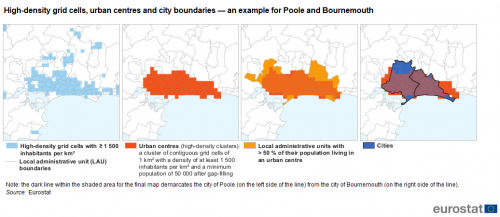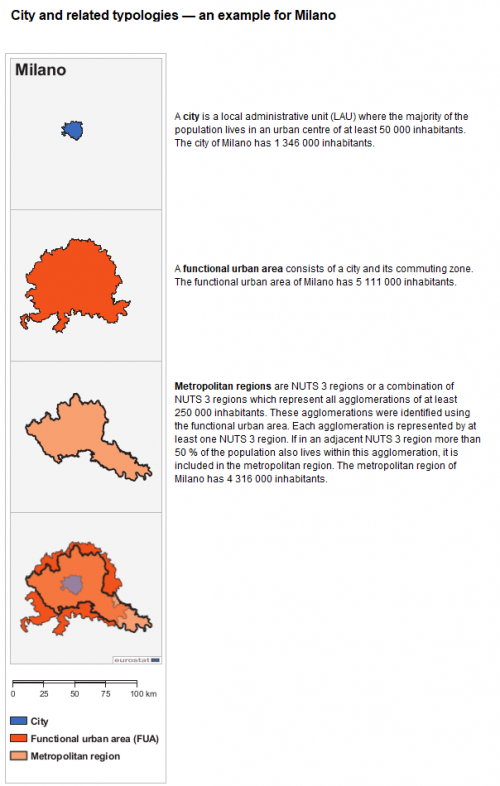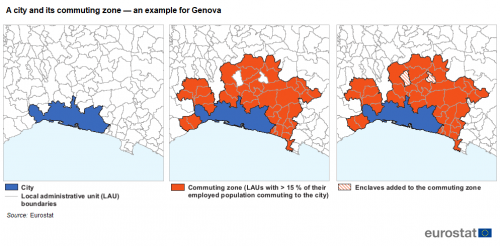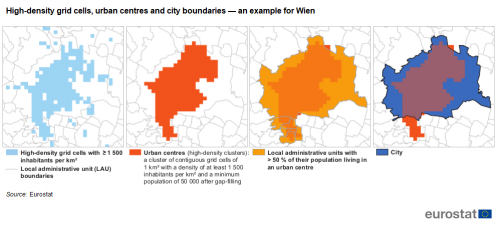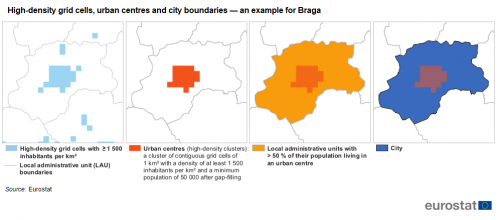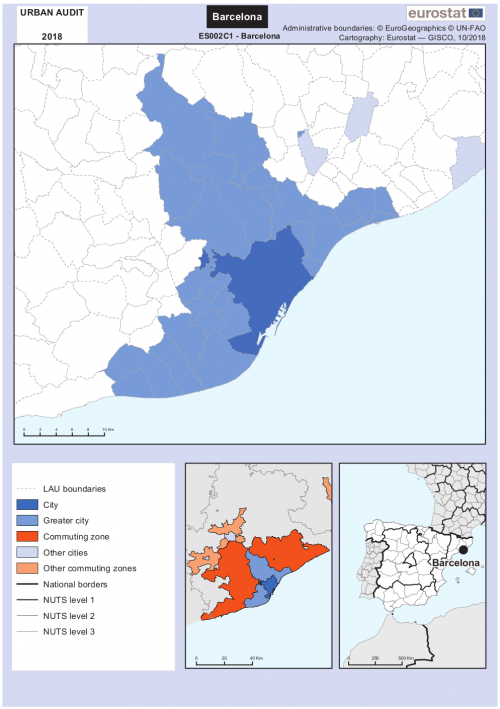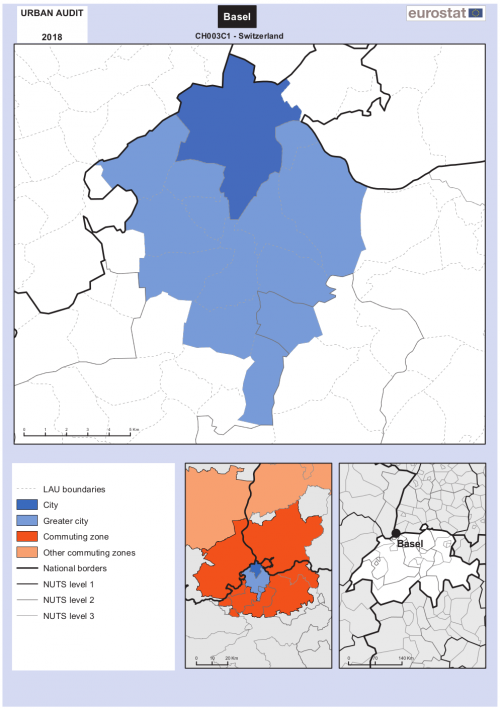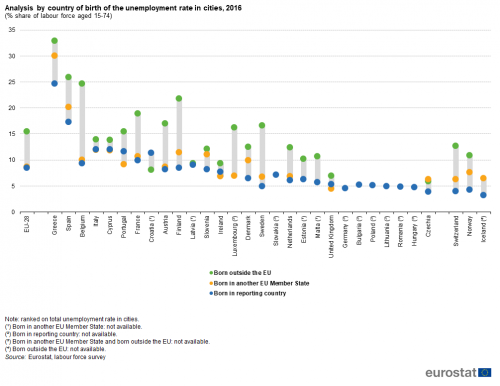Territorial typologies manual - cities, commuting zones and functional urban areas
This article forms part of Eurostat’s methodology manual on territorial typologies.
 |
A city is a local administrative unit (LAU) where a majority of the population lives in an urban centre of at least 50 000 inhabitants.
A commuting zone contains the surrounding travel-to-work areas of a city where at least 15 % of employed residents are working in the city. A functional urban area consists of a city and its commuting zone. Functional urban areas therefore consist of a densely inhabited city and a less densely populated commuting zone whose labour market is highly integrated with the city (OECD, 2012). |
Full article
Classes for the typology and their conditions
Details of the typology
Functional urban areas are a classification based on the following two categories:
- cities, otherwise referred to as densely populated areas;
- commuting zones.
Note these two categories are not exhaustive; they do not cover the whole territory.
Methodology for the typology
The starting point for defining a city and its commuting zone is to consider what features form a city. The definition used builds on the idea of a city as a place with a relatively high spatial concentration of population.
The main building blocks are data for 1 km² population grid cells. Each grid cell has the same shape and surface area, thereby avoiding distortions caused by using units varying in size. This is a considerable advantage when compared with alternative approaches such as those based on the use of administrative data for LAUs (such as municipalities).
Step 1: classifying grid cells
These 1 km² population grid cells are plotted in relation to their neighbouring cells to identify cluster types; note this is the same process that is used for the degree of urbanisation typology (see Chapter 2). The cluster type used to identify cities is that of:
- urban centres (or high-density clusters): a cluster of non-diagonal contiguous grid cells (in other words, excluding those cells with only touching corners) having a population density of at least 1 500 inhabitants per km² and collectively at least 50 000 inhabitants after gap-filling.
For a more detailed explanation of how densely populated grid cells are classified to urban centres (including the gap-filling process), see Chapter 1.
Step 2: classifying cities
The typology for functional urban areas is established at the level of local administrative units (LAUs). Once all grid cells have been classified and urban centres identified, the next step concerns overlaying these results onto LAUs, to identify cities:
- cities (densely populated areas) — where at least 50 % of the population lives in one or more urban centres (note this definition is identical to that used for the degree of urbanisation typology).
A city is defined in an identical way to the approach adopted for the degree of urbanisation (see Chapter 2) when identifying densely populated areas (and thereafter cities). In both of these typologies, cities are covered by the exact same local administrative units. There is, however, a difference in the coding of the two concepts. The degree of urbanisation classifies all local administrative units in three groups, which means that all the densely populated areas or all cities get the same code. Each city is assigned an individual code, which allows LAUs for each city to be grouped and classified (by population size). In simple terms, the degree of urbanisation typology results in data that may be analysed at an aggregate level for all of the cities in a specific country, while the functional urban area definition allows data to be analysed at the level of each individual city.
In most cases, defining a city is a simple task, insofar as the city consists of a single administrative unit that covers the entire urban centre. However, in some cases the relationship between LAUs and urban centres may be more complex — these are examined below.
The urban centre is much bigger than the ‘central’ administrative unit
In some cases, the urban centre may stretch far beyond the boundaries of the ‘central’ LAU (or municipality). This is often the case with large capital cities that have outgrown the small LAU that carries their name. To strictly define the city as the central LAU would create a problem of ‘under-bounding’, in other words the city would be too small relative to its urban centre and a large share of the population living in the urban centre would inhabit areas outside the city. As the methodological definition of a city states that all LAUs with at least 50 % of their population in the urban centre are part of the city, the boundaries of the city are extended to include these units (in order to better capture and represent all urban centres).
To avoid any confusion between the ‘central’ LAU which gives its name to the city and this broader concept covering greater cities, Eurostat gives preference to analysing information for greater cities (when available). In some EU Member States, such cities can be easily identified as they have the prefix ‘greater’ added to the city name, for example, the Métropole du Grand Paris (France) or Greater London (the United Kingdom). Otherwise, some greater cities are defined as a combination of two or more cities: for example, the greater city of Porto (Portugal) is made up of five cities (Porto, Vila Nova de Gaia, Gondomar, Valongo and Matosinhos). In a few cases, the greater city may include several cities and other communes, for example, Milan, Naples (both Italy), Rotterdam (the Netherlands) or Helsinki (Finland).
The urban centre covers two (or more) distinct cities
Some urban centres cover more than one (distinct) city. This can be due to inaccuracies in the population grid or because two (or more) cities have almost grown together — but remain functionally distinct. In such cases, a national statistical authority may choose to create multiple cities to cover the single urban centre. Note that when multiple cities are defined as covering a single urban centre, each of the (distinct) cities should have a population of at least 50 000 inhabitants.
Poole and Bournemouth (in the United Kingdom, see Figure 1) provide an example: they share a single urban centre, but are identified as two distinct cities. These two cities may still belong to the same (single) commuting zone if one of the cities has a flow of commuters to the other city that reaches at least 15 %.
A city includes more than one urban centre
This situation is usually caused by topographical features, such as a wide river/estuary or a mountain ridge that may lead to an urban centre being split into two unique parts; this occurs, for example, in Tromsø (Norway). In such a case, the city is defined to cover both urban centres.
The administrative unit is located between two urban centres
If an LAU has a share of its population in two urban centres, the unit should belong to the urban centre that captures the largest share of its population; even if that share is below 50 %. For example, if an LAU has 40 % of its population in urban centre A and 20 % of its population in urban centre B, then it should be classified as part of the city that represents urban centre A.
Step 3: classifying commuting zones
As a final step, the commuting zone is defined. The city plus its commuting zone forms what is known as a functional urban area.
- commuting zones — are based on commuting patterns:
- if at least 15 % of employed persons living in one city work in another city, these cities are treated as a single destination for the commuting analysis;
- all LAUs from which at least 15 % of the employed population commute to the city are identified as commuting zones;
- enclaves (LAUs surrounded by a single functional urban area) are included as part of the commuting zone and exclaves (non-contiguous LAUs) are excluded from commuting zones;
- functional urban areas — are defined as a city and its commuting zone. In cases where cities are connected by commuting, the functional urban area may consist of multiple cities and their single commuting zone. There are a few cases where cities do not have a commuting zone: for these, the city is equal to the functional urban area.
The destination to be used for identifying commuting flows should be the best approximation of the urban centre. For cities where their boundary is adjusted (see below) to match the boundaries of a city administration, the commuting zone should ideally be based on the unadjusted boundaries, in other words, before adding or excluding LAUs.
Data availability can also require the commuting zone to be defined at a more aggregated geographical level. For example at NUTS level 3 instead of for LAUs. In such cases, it is better to first define the commuting zone at the LAU level and only subsequently match this with NUTS level 3 regions. The OECD uses the same approach in the United States, where commuting zones are first defined at the census tract level, which is subsequently matched with data for counties.
Identifying unique commuting zones
To classify commuting zones the first step is to identify if there are any polycentric developments, in other words, commuting zones that are characterised by two (or more) cities that are linked by their commuting flows. If city A has 15 % of its employed residents commuting to city B, then the two cities are classified as sharing a single commuting zone; note that city B does not also need to have a flow of at least 15 % of its employed residents commuting to city A. In more complex cases involving three cities, the following rules should be applied:
- if both city A and city B have commuting flows of more than 15 % of their employed residents to city C, then all three cities share a single (unique) commuting zone;
- if city A has a commuting flow of 20 % to city B, while all remaining commuting flows between cities A, B and C are less than 15 %, then cities A and B will have a shared commuting zone, while city C will have its own, (individual) commuting zone.
Assigning local administrative units to commuting zones
The next step is to determine if the remaining LAUs (outside of the city) belong to a commuting zone, again based on identifying all LAUs with at least 15 % of their employed residents working in the city (or two or more cities in those cases where cities share a commuting zone).
If an LAU has a commuting flow of more than 15 % of its employed residents to more than one city, it should become part of the commuting zone of that city for which it has the largest commuting flow. For example, if an LAU has a commuting flow of 20 % of its employed residents to city A and 17 % of its employed residents to city B, then it should be considered as part of the commuting zone for city A.
An enclave is defined as an LAU that shares 100 % of its land border with a single (unique) functional urban area; water borders are not considered. In such a case, the LAU is assigned to the commuting zone. By contrast, exclaves (or non-contiguous LAUs), in other words, those LAUs that do share a common border with the functional urban area should be dropped from the commuting zone. As a result, the resulting commuting zone should be an integrated, contiguous area around the city (as shown in Figure 3).
Further adjustments for cities and their commuting zones
As noted above, the typology for cities is based on information for 1 km² population grid cells, which helps overcome problems associated with units that vary in size. This methodology usually results in a closer match between urban centres and densely populated LAUs for those EU Member States that are characterised by relatively small LAUs, as these minimise any shifts in population between the grid classification and the classification of LAUs. Despite making use of the grid concept, there may be a variety of distortions when defining city boundaries that are linked to the size of LAUs and the political/administrative organisation of cities (these are discussed below). The adjustments that are made to take account of these distortions generally result from requests made by national statistical authorities, which are subsequently verified by the European Commission.
Large local administrative units may lead to an urban centre that is not represented by a city
Large LAUs may result in an urban centre not having a single LAU with at least 50 % of its population in that urban centre; this is more likely to happen for relatively small urban centres (with a population just above 50 000 inhabitants). In such a case, there are two options, neither of which is ideal:
- classify the LAU with the highest share of its population in that urban centre as a city;
- do not classify any LAU as a city.
The first option leads to an over-representation of the population in the urban centre, the second leads to an under-representation (or non-representation) of the population in the urban centre. The latter usually arises for those EU Member States characterised by relatively large LAUs: indeed, they are systematically biased towards an under-representation of smaller cities. For example, if a Member State has administrative units composed of at least 200 000 residents, then the urban centre will need to have a population of at least 100 000 residents for it to be classified as a city.
Small local administrative units may impact on links to the city administration
In those EU Member States characterised by fairly large LAUs, most cities consist of a single administrative unit. However, in Member States characterised by smaller administrative units, individual cities may be composed of multiple administrative units.
Some EU Member States are characterised by cities being administered at a more aggregated level than other parts of their territory. For example, in Portugal part of the degree of urbanisation classification (for towns and suburbs and for rural areas) is applied at the parish level (freguesia), whereas cities are organised at the municipal level (municipio or concelho); note that the level applied for cities has to be identical for both the degree of urbanisation and functional urban areas. Other Member States have created a unique level of administration to govern their largest cities: for example, France has 21 métropoles for administering its biggest cities. In order to facilitate a better link to these different levels of administration, which do not emerge automatically if using smaller administrative units, the following two cases may be applied when classifying cities:
- a local unit with at least 50 % of its population in an urban centre can be excluded from the city as long as 75 % of the population of the urban centre is covered by that city (case 1);
- a local unit without 50 % of its population in an urban centre can be added to a city if that unit is included as part of the city administration and at least 50 % of the population of the ‘expanded’ city lives in the urban centre (case 2).
These two cases provide clear statistical limits to the changes that may be made, insofar as all cities should have at least 50 % of their population living in an urban centre and all urban centres should have at least 75 % of their population living in a city.
Case 1: excluding local administrative units
An example of the first case is provided by the Austrian capital of Wien. Several LAUs just south of the city have 50 % or more of their population in the urban centre of Vienna, although they are not within the boundaries of the city’s single administrative body. As more than 75 % of the population of the urban centre live in the city of Vienna, these administrative units (Gemeinden shown in orange outside of the blue city area in the right hand part of Figure 4) can be dropped from the city without significantly compromising the comparability of the results, thereby ensuring a direct link to the political/administrative organisation of the city.
Case 2: adding local administrative units
An example of the second case is provided by the Portuguese city of Braga. The Munícipo de Braga (the municipality of Braga in the north of Portugal) is delineated by an area that is somewhat bigger than that initially identified for the collection of city statistics. However, as more than 50 % of the population of Braga still live within the urban centre, several relatively small administrative units (freguesias) around the city have been added to its definition without significantly compromising the comparability of the results (see Figure 5), thereby ensuring a direct link between the statistics presented and the political/administrative organisation of the city.
Urban centres that have a population that is close to the threshold of 50 000 inhabitants
The methodology provides an estimate of the population for an urban centre. Two elements may reduce the accuracy of this estimate: i) geographic features and ii) the source of the population grid data.
The methodology does not take into account the specific geography/topography of a city. Some features, such as steep slopes, cliffs or bodies of water may lead to an underestimation of population size for urban centres: this may affect, in particular, those cities characterised by a small urban centre; in these cases, an expert decision should be taken.
Defining cities with a strong separation of functions
In those EU Member States where land use planning enforces a strong separation of functions (industrial, commercial and residential) and where there is a relatively low level of population density in cities, the methodology may lead to excessive fragmentation of urban centres. In these cases, grid cells with shopping malls, transport infrastructure or business parks are unlikely to reach the population density threshold and hence are excluded from urban centres, creating non-contiguous, fragmented grid cells for urban centres.
To resolve this issue, population grid cells which are at least 50 % built-up may be added to the urban centre. This resolves the problem for this specific type of city and has little to no impact on those cities which are more densely populated, as virtually all of their grid cells which are at least 50 % built-up have a population density above the threshold or are added as part of the gap-filling process.
Case studies
The two maps which follow illustrate some specific cases.
Map 1 shows the development of the city of Barcelona, which has been constrained by the sea to the south-east and by some mountainous terrain to the north-west. The greater city and functional urban area of Barcelona reflect, to some degree, the main transport arteries that lead into the city (as used by commuters), with a relatively large amount of urban development along the coastline, as well as inland on the other side of the mountains (which are circumvented by a series of road tunnels).
Map 2 provides an example of a transnational functional urban area, delineating the functional urban area of Basel in Switzerland (the only other transnational functional urban area is also in Switzerland, namely, that of Genève). The functional urban area of Basel includes the region of Basel-Stadt, while the commuting zone extends into parts of the surrounding region of Basel-Landschaft, as well as across the border to cover some LAUs in the neighbouring regions of Haut-Rhin (France) and Lörrach (Germany). Note that national functional urban areas (based on commuting flows within a single country) cannot overlap, whereas transnational functional urban areas (based on national and transnational commuting flows) may overlap with national functional urban areas. For instance, the French administrative unit of Petit-Landau (FR68254) is part of the transnational functional urban area of Basel in Switzerland (CH003T2) and is also part of the national functional urban area of Mulhouse in France (FR040L2).
Links to other spatial concepts/typologies
As shown in Figure 2 in the introductory chapter and in the specific example of Figure 2 above, the local typologies for functional urban areas and the degree of urbanisation (see Chapter 2 for more information) are closely linked, insofar as the common concept of the city is used within both classifications and is defined in an identical manner: LAUs where a majority of the population lives in an urban centre of at least 50 000 inhabitants. While cities share a common definition, the degree of urbanisation also identifies towns and suburbs (or intermediate density areas) and rural areas (or thinly-populated areas). These two categories partially overlap with the commuting zones: towns and suburbs occur both inside commuting zones (more likely if they are suburbs) and outside (more likely if they are towns); while rural areas primarily fall outside commuting zones, some have a strong relationship with a nearby city and are therefore also classified as commuting zones.
There is also an indirect link between functional urban areas and a regional typology, insofar as the former are used as a building block to construct the typology for metropolitan regions (see Chapter 6), which are defined as one or more NUTS level 3 regions with at least 50 % of their regional population living inside a functional urban area with at least 250 000 inhabitants.
Note that one region (at NUTS level 3) can contain more than one city and/or more than one functional urban area: for example, the Czech region of Ústecký kraj has three of each (Chomutov-Jirkov, Most and Ústí nad Labem), while the same is true for the Spanish region of A Coruña (A Coruña, Ferrol and Santiago de Compostela). Each functional urban area with more than 250 000 inhabitants needs to be captured by a metropolitan region composed of one (or more) NUTS level 3 region(s).
Results
Based on the above definitions, there were 960 cities and 715 functional urban areas in the EU-28 covered by the city data collection exercise in 2017. For 40 of these cities, information was collected for both the ‘core’ city and the ‘Greater’ city concept. Map 3 provides an overview of the final classification.
For all EU Member States, Iceland, Norway, Switzerland and Turkey, a list of cities and their functional urban areas is available here. Note that for the purpose of this typology, the 33 individual boroughs that make-up Greater London are considered as cities in their own right (for example, Barking and Dagenham, Hammersmith and Fulham, Islington, or Wandsworth).
Changes to the typology over time
Historical developments
The collection of statistics for cities started in the 1990s. Data on European cities with more than 100 000 were collected through the Urban Audit and the Large City Audit projects. Their ultimate goal was to contribute towards improvements in the quality of urban life by: supporting the exchange of information/experiences between EU cities; helping to identify best practices; facilitating benchmarking across the EU; providing information on the dynamics within the cities and between cities and their surrounding areas. Within the Urban Audit, cities were previously referred to as ‘core cities’, greater cities were previously referred to as ‘kernels’, while functional urban areas were previously referred to as ‘larger urban zones’.
In 2011, the European Commission and the OECD developed a harmonised definition of a city and its commuting zone, which led to extension of the city list, resulting in better coverage and geographical comparability.
Changes over time that impact on the classification
The functional urban areas classification should be updated to reflect changes to the underlying sources of information that are used in the compilation of these statistics. As such, the classification may be updated to reflect: changes to LAUs and other administrative boundaries; changes to population distributions for 1 km² grid cells; or changes to the underlying data that were used to identify commuting shares. The frequency of such updates therefore varies according to the source of information.
Changes to functional urban areas resulting from a revision of population distributions for 1 km² grid cells or underlying information for commuting shares are relatively scarce, with their main source being population and housing censuses which are generally conducted every 10 years. The next major update of the population grid is foreseen to take place for the 2021 reference year. However, with an increasing number of countries expected to switch to a register-based census in the future, it might be possible to have more frequently updated information on commuting flows/zones.
For the EU as a whole, the boundaries of cities and functional urban areas are updated once a year based on changes in the LAU list. New codes are assigned by Eurostat after notification to the national statistical authorities. The resulting list of cities and functional urban areas is then used as the basis for the city statistics data collection.
Future developments
Eurostat is in the process of consolidating the list of cities and greater cities used within the city statistics data collection. Cities and greater cities are, at the time of writing, distinguished within the database through the coding system: greater cities are coded with a K, while other cities are coded with a C.
Among the ideas that have been discussed for future developments, Eurostat has considered systematically adding the term ‘Greater’ to the name of all greater cities and then modifying the codes concerned so that all greater cities are coded with a C. As such, the default level of analysis will be the harmonised code (C) — composed of greater cities and all other cities (for which no information is available at the level of the greater city). Cities inside greater cities will thereafter be reclassified as components of the greater city and will not form part of the default level of analysis.
Further information
Glossary entries:
Detailed methodology:
Methodological manual on city statistics, Eurostat (2017)
The EU-OECD definition of a city, commuting zone and a functional urban area, European Commission and the OECD
Dedicated section:
Correspondence for local administrative units:
Correspondence table for LAUs and cities
Publications:
Urban Europe — Statistics on cities, towns and suburbs, Eurostat (2016)
The state of European cities report, 2016 — cities leading the way to a better future, European Commission, Directorate-General for Regional and Urban Policy (2016)
Quality of life in European cities, Eurobarometer (2016)
Published indicators
Visualisation tools:
Eurostat publishes data on cities through Regions and cities illustrated.
Database:
The city statistics database provides data relating to most aspects concerning the quality of life in the cities of EU Member States, Iceland, Norway, Switzerland and Turkey. The datasets encompass statistical information on individual cities and on functional urban areas. The data collection exercise is undertaken jointly by national statistical authorities, the Directorate-General for Regional and Urban Policy and Eurostat.
Eurostat’s website provides information on 233 variables/indicators for around one thousand different cities. Note that as these statistics are provided solely for cities and for functional urban areas, it is necessary to derive information for commuting zones by subtracting the data for cities from that for functional urban areas (in those cases where the variable/indicator concerned is additive).
Data on cities and functional urban areas are available for the following statistical domains: demography, living conditions, education, culture and tourism, the labour market, economy and finance, transport and the environment. Data availability differs across statistical domains from year to year, in part reflecting the fact that these statistics are provided on a voluntary basis (in other words, there is no EU legislation covering the collection of these statistics). These statistics are available here.
There is also a separate data collection exercise that concerns a perception survey for the quality of life in European cities; the most recent survey took place in 2015 and covered 79 cities across the EU Member States, Iceland, Norway, Switzerland and Turkey. This survey is organised by the Directorate-General for Regional and Urban Policy and the next reference year will be 2018. For more information, see the European Commission’s website.
Data from the perception survey cover the satisfaction of individuals living in cities in terms of: their overall experience of living in the city; their satisfaction with their city’s infrastructure, facilities and environment; their views concerning various aspects of life in their city (employment opportunities; the housing situation; the presence and integration of foreigners; safety and trust; or city administrative services); their satisfaction with their personal situation; as well as the three most important issues that they feel need to be addressed in their city.
Examples
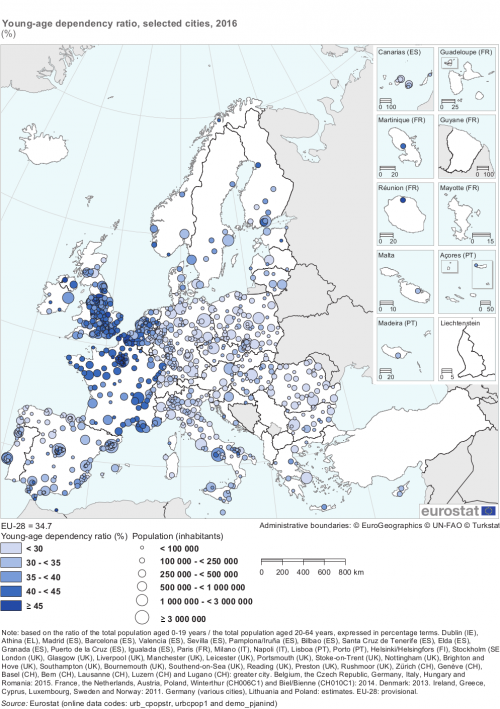
(%)
Source: Eurostat (urb_cpopstr), (urbcpop1) and (demo_pjanind)
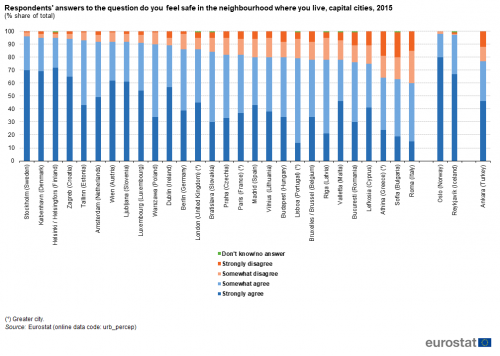
(% share of total)
Source: Eurostat (urb_percep)
Direct access to
- Urban Europe — Statistics on cities, towns and suburbs: Eurostat (2016)
- The state of European cities report, 2016 — cities leading the way to a better future: European Commission, Directorate-General for Regional and Urban Policy (2016)
- Quality of life in European cities: Eurobarometer (2016)
- Urban Audit - Perception survey on quality of life in 79 European Cities: European Commission, Directorate-General for Regional and Urban Policy
